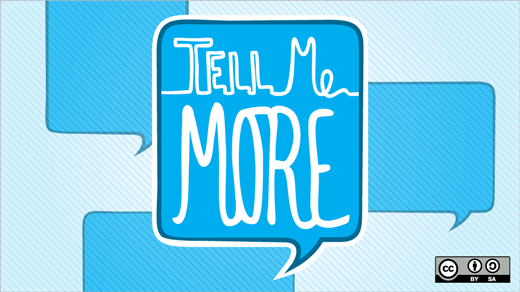Using an inclusive process can lead to better group decisions—ones that empower a group and grant it ownership of the decision. But all open decision making processes should do something else if they're going to succeed: enable dissent.
Dissent is incredibly important to successful open decision making. When you're seeking collaboration on an important decision, you don't want to be surrounded by people who always agree with everything you say. You already know everything that you're saying and what you believe to be the best path forward. However, you also know (or should know) that your knowledge, experience, and visibility of the entire picture is limited. What you really need are perspectives from people with knowledge, experience, and visibility complementary to yours. That helps round out your perspective—people who will bring up something that you didn't think of or didn't fully comprehend its importance.
In this article, I'll explore in more depth the importance of dissension during decision making. I'll present a compilation of ideas from a number of my colleagues (at Red Hat), which arose in an open forum discussion we had on the subject.
It's not easy
Enabling dissent and empowering people to take part in making collaborative decisions is not an easy task. People may not wish to actively disagree with a leader for a number of reasons. After looking at them, I'll discuss a number of approaches that should work to mitigate these issues. Keep in mind that this is not an inclusive list (there are plenty of other reasons why someone may not speak up during a meeting!).
- Strictly hierarchical national cultures: Some countries promote cultures of obedience to hierarchy. In these, people are taught from the time they are young to always be respectful, that a senior person knows everything, and that they should never disagree with someone in a position more senior than theirs. Giving a contrary opinion in a large meeting may be very difficult for them.
- Lower self-confidence: People are afraid of being wrong or failing. In the past, if they've made suggestions that others dismissed, they may feel hesitant to offer other opinions in the future. Similarly, if the group did accept their idea, but their idea led to failure, then this can also severely lower their self-confidence.
- New ideas: People may need time to really think about and reflect on new ideas when they hear them. There might be a feeling, for example, that an idea is "missing something," but people won't know exactly what. They might want to do additional research or take time to recall exactly where they saw an article discussing this exact point before speaking up.
- Fear/lack of psychological safety: Sometimes people are concerned that their positions might be threatened if they disagree with an idea. They may be afraid that people will laugh at their suggestions. This may or may not be based on a realistic repercussion in this specific situation, but it may be based on past experience or grapevine chatter.
- Disbelief that their input will be taken into account: A leader may pay lip service to open decision making, but might ultimately not enable the other members of the group to influence a decision. This is disheartening and demotivating for team members. Someone who believes a leader will follow his or her own opinion, no matter what others on the team say, will see no benefit in speaking up.
Of course, there is also the opposite problem: when you fully enable dissent, but people disagreeing with you believe they're completely correct and continue arguing even after their points have been rejected. Some people will vehemently argue about anything and everything.
Unleashing the power of dissent
When presenting an idea and asking for opinions in a meeting, plenty more great ideas and perspectives may be left unsaid. How can we unleash the power that this potential represents?
This generally requires a multi-faceted approach. These steps constitute the "ADOPT opinions method":
- Ask for ideas before you present a proposal. This removes dissent from the picture because instead of disagreeing with you people are actually helping to build a proposal. Tell them what you want to know in advance to give them time to think, research, and understand. Ask them to email you ideas in advance and personally encourage people to participate. This can be time-consuming work, but it is worthwhile in the end. When you do put together the proposal, make sure that it includes the ideas you received. If something wasn't taken into account, let people know why. During the meeting where you present the proposal, call out the people who made suggestions and thank everyone for their important contributions.
- Decisions shouldn't be finalized in a meeting. After people have raised ideas, send a survey with the options and ask the group what they think of the idea. This will give them time after the meeting to fully think over what you are suggesting, research it, and form an opinion. In certain circumstances, allowing anonymous feedback might also make sense.
- Open conversations with people individually if you think someone isn't going to speak up in public. Tell them their opinion is very valuable to you. Having these informal discussions is a great way to get feedback from people raised in strict hierarchical cultures as well.
- People can be called on during the meeting, if it's a small enough group. Ask them specifically what they think and how it impacts them. If the meeting is too large for that, you can try a thumb or spotlight approach.
- Thank people for their dissenting opinions. Even if they aren't accepted, showing appreciation will go a long way in building the safe environment for people to express themselves freely. When someone presents a perspective, respond to what they're talking about and not to the person themselves. Instead of "You never think things through," try something like "Great idea, but I see some challenges involved. Let's think about how we can overcome them."
Using this method can empower your group to fully explore various ways to achieve their objectives. It should present decision makers with all available perspectives and enable them to make the decision that is best for the group.
Best of all, since they've been included in a decision making process, the entire group will feel ownership over the decision and passionately work to implement and execute it.







Comments are closed.